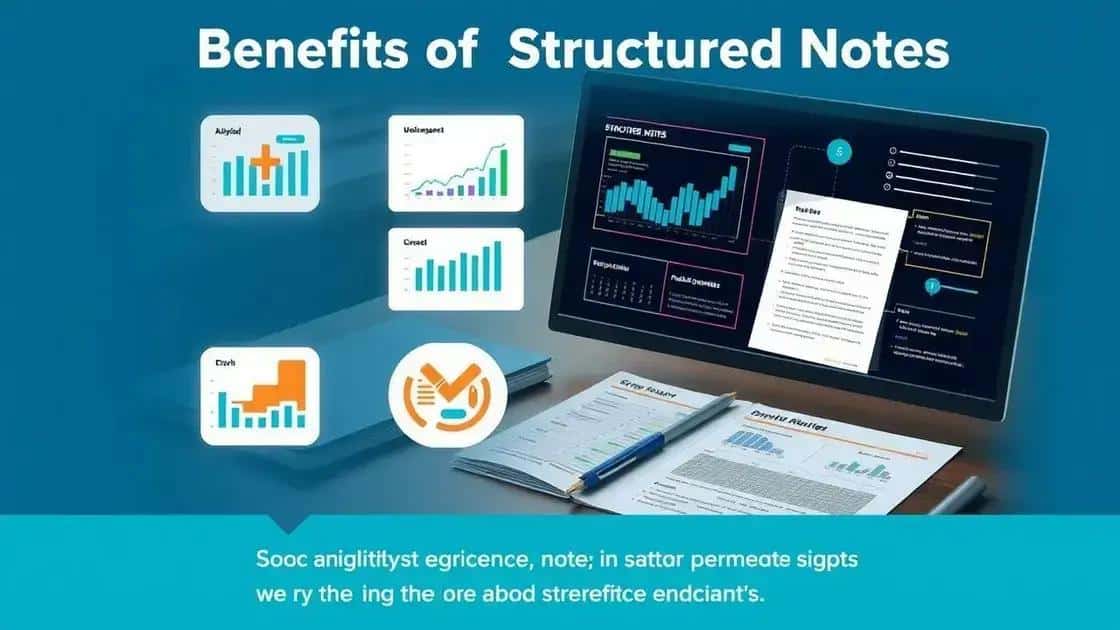Structured notes in conservative portfolios: a smart strategy

Structured notes in conservative portfolios provide enhanced returns and downside protection, making them a valuable investment option for risk-averse investors seeking stability and growth.
Structured notes in conservative portfolios offer a unique way to balance risk and reward. Have you ever wondered how these financial instruments can work for you? Let’s dive into their potential benefits!
Understanding structured notes
Understanding structured notes is essential for anyone looking to enhance their conservative portfolio. These financial instruments are tailored to meet specific investment needs while providing potential downside protection. Structured notes can differ in their features and risks, making it crucial to grasp their fundamentals.
What Are Structured Notes?
Structured notes are debt securities linked to the performance of an underlying asset, such as a stock, bond, or index. These products combine traditional bonds with derivatives, which can lead to unique payout scenarios. They are issued by banks and typically have fixed maturities.
Key Features of Structured Notes
- Customizable payouts: Investors can choose notes that align with their specific goals and risk appetite.
- Downside protection: Certain structured notes offer principal protection, which can be beneficial in volatile markets.
- Potential for enhanced returns: By linking returns to the performance of underlying assets, structured notes may provide higher yields compared to plain bonds.
Investors should carefully consider the terms of structured notes. Unlike traditional investments, they can have complex payoff structures. It’s essential to review the prospectus to understand the risks involved. For example, if the underlying asset performs poorly, the returns may be less than anticipated.
Another important aspect of structured notes is their liquidity. Some notes may be traded on secondary markets, while others may require holding until maturity. Understanding your options in this regard can significantly impact your investment strategy.
In conclusion, grasping the basics of structured notes is vital for effectively incorporating them into a conservative portfolio. With their potential for customizability and downside protection, they can be a valuable addition to your investment toolkit, provided you thoroughly understand their mechanics and risks.
Benefits of structured notes in conservative portfolios

The benefits of structured notes in conservative portfolios are noteworthy and can significantly impact investment strategies. These financial instruments provide a way to balance safety with potential growth. Investors often seek lower-risk options, and structured notes can meet these needs effectively.
Potential for Enhanced Returns
One of the primary advantages of using structured notes is the opportunity for enhanced returns compared to traditional fixed-income securities. By linking the performance to an underlying asset, these notes can offer higher payouts if the benchmarks are met.
Downside Protection
Structured notes often come with built-in protective features. Many designs include principal protection, ensuring that investors receive at least a portion of their initial investment back, even in poor market conditions. This safety net can be particularly appealing during times of volatility.
- Customizable investments: Investors can choose structured notes that align with their individual risk tolerance and financial goals.
- Inflation protection: Some structured notes are designed to deliver returns that may outpace inflation, preserving purchasing power.
- Tax advantages: Depending on the structure, some notes may have favorable tax treatment compared to regular investment income.
Incorporating structured notes into a conservative portfolio allows investors to diversify their assets while still aiming for gains. The unique features of these notes can make them a compelling option for those who prioritize security yet desire moderate returns.
Overall, the strategic integration of structured notes can lead to a more robust investment portfolio. Their blend of safety and potential for higher earnings makes them an attractive consideration for conservative investors looking to optimize their returns without taking on excessive risk.
Risks and considerations
When exploring structured notes, it’s important to understand the risks and considerations involved. While these financial instruments can offer benefits, they also carry specific challenges that investors should be aware of.
Market Risk
One major risk associated with structured notes is market risk. The performance of these notes is linked to underlying assets. If the market declines, the notes may not perform as expected. Investors must be prepared for potential losses if the market does not move favorably.
Liquidity Risk
Another consideration is liquidity risk. Many structured notes may not be easily tradable before their maturity. This can lead to challenges if an investor needs to access their funds quickly. It’s essential to evaluate how easily you can sell your notes if required.
- Complexity: Understanding the terms and structure of these notes can be complicated. Investors should thoroughly review the offering documents.
- Credit Risk: Since structured notes are issued by financial institutions, there’s a risk of default. If the issuer encounters financial difficulties, it could affect your investment.
- Taxation: The tax implications of structured notes can vary. Some returns may be subject to higher taxes, depending on the structure.
Investors should also consider their investment horizon. Structured notes are typically designed for specific periods, which may not align with your financial goals. Make sure you assess whether the maturity matches your needs before investing.
Evaluating whether to include structured notes in a conservative portfolio requires careful thought. Always weigh the potential risks against the benefits to make informed decisions that suit your financial situation.
How to incorporate structured notes into your strategy

Incorporating structured notes into your investment strategy can enhance your conservative portfolio. It’s important to approach this addition with a clear understanding of your financial goals and risk tolerance. Knowing how to effectively integrate these financial instruments is key to maximizing their benefits.
Assess Your Financial Goals
Before adding structured notes to your strategy, assess what you want to achieve. Are you looking for income generation, capital appreciation, or both? Having clear objectives will guide your selection of the right notes.
Understand Your Risk Tolerance
Understand your risk appetite before investing in structured notes. Some notes provide principal protection, while others may not. Determining how much risk you are willing to take on will help in choosing the appropriate instruments.
- Research Different Types: Explore various structured notes available on the market. Each note may serve different purposes and offer different risks and rewards.
- Consult Financial Advisors: Engaging with a financial advisor can provide insight into how structured notes align with your portfolio goals.
- Diversify Your Holdings: Incorporating structured notes with other asset classes can help balance your portfolio, providing stability while aiming for growth.
Investing in structured notes requires a strategy to monitor your investments continually. Keep an eye on performance relative to your goals and market conditions. Adjust your holdings as necessary to stay aligned with your financial aspirations.
Another practical step is to choose a reputable issuer. The credit quality of the institution offering the structured note is crucial. This can influence the security and returns of your investment. Always check the issuer’s reputation and consider conducting thorough due diligence before making a commitment.
Incorporating structured notes into your strategy should feel like a natural fit within your overall investment philosophy. By aligning them with your objectives and risk tolerance, you can enjoy the unique benefits they offer, contributing to a more robust conservative performance in your portfolio.
FAQ – Frequently Asked Questions about Structured Notes in Conservative Portfolios
What are structured notes?
Structured notes are investment products that combine debt securities with derivatives to offer customized returns based on the performance of underlying assets.
What benefits do structured notes provide?
Structured notes can offer enhanced returns, downside protection, and customizable investment options suitable for conservative portfolios.
Are there risks involved with structured notes?
Yes, risks include market risk, liquidity risk, credit risk, and the complexity of understanding the notes’ terms and conditions.
How can I incorporate structured notes into my investment strategy?
To incorporate structured notes, assess your financial goals, understand your risk tolerance, research available options, and consult with financial advisors.





